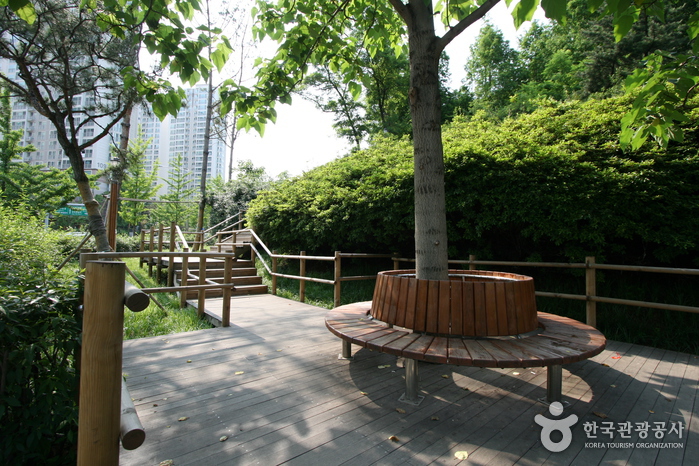Galaxy Lifestyle - Lotte Gangnam Branch [Tax Refund Shop] (갤럭시라이프스타일 롯데 강남점)
12.5Km 2024-04-23
7F, 401, Dogok-ro, Gangnam-gu, Seoul
-
Beanpole - Lotte Gangnam Branch [Tax Refund Shop] (빈폴 롯데 강남점)
12.5Km 2024-04-22
7F, 401, Dogok-ro, Gangnam-gu, Seoul
-
Olive Young - Yongin Gugal Branch [Tax Refund Shop] (올리브영 용인구갈)
12.6Km 2024-04-19
Store #101, 64, Gugal-ro, Giheung-gu, Yongin-si, Gyeonggi-do
-
Olive Young - Seokchon Station Branch [Tax Refund Shop] (올리브영 석촌역)
12.6Km 2024-04-18
387, Baekjegobun-ro, Songpa-gu, Seoul
-
Ogeum Park (오금공원)
12.6Km 2025-01-17
363 Ogeum-ro, Songpa-gu, Seoul
Ogeum Park is a park created by cultivating a mountain with an altitude of 200 meters, providing a panoramic view of Seoul's Songpa district. The park features walking trail, various exercise equipment, and facilities such as badminton and tennis courts. The lawn bowling court is available for use by reservation. There is a toddler forest experience ground and an adventure playground for children, offering activities like rope climbing, rock climbing, net climbing, slides, and spider web climbing.
Gwacheon Wildflower Nature Learning Center (과천야생화자연학습장)
12.6Km 2023-07-17
118, Gyoyugwon-ro, Gwacheon-si, Gyeonggi-do
Gwacheon Wildflower Nature Learning Center was opened to provide a place to learn about nature and harmony. The area is 6,900㎡ and has approximately 112 species of wildflowers. The learning center is divided into sections according to the type and use of wildflowers. The learning center also houses a traditional tightrope walking education center. Korean tightrope walking is registered as a UNESCO Intangible Cultural Heritage of Humanity. The site offers an educational tightrope walking experience program for those interested.
Golfzon Market - Jamsil Branch [Tax Refund Shop] (골프존마켓 잠실)
12.6Km 2024-04-18
71, Samjeon-ro, Songpa-gu, Seoul
-
Korea Electric Power Corporation (KEPCO) Art Center (한전아트센터 공연장)
12.6Km 2024-03-20
60, Hyoryeong-ro 72-gil, Seocho-gu, Seoul
The KEPCO Art Center is a cultural complex that provides opportunities to experience a diverse range of arts and culture. The Grand Theater's performances range from musicals and operas to classical and pop music. It offers excellent works that have undergone a rigorous selection process. The center's gallery, electricity museum and sports club are all located in one space, offering a one-stop exploration.
Anyang Produce & Fish Wholesale Market (안양농수산물도매시장)
12.6Km 2024-02-16
313 Heungan-daero, Dongan-gu, Anyang-si, Gyeonggi-do,
Anyang Produce & Fish Wholesale Market is a hub of logistics in the southern region of the metropolitan area. It's a bustling center for both wholesalers and consumers. The market includes distinct sections such as a fruits wing, a vegetables wing, and a fishery wing. In addition to these, there are also commercial wings and storage units. Wholesale auctions take place in the early mornings, while trades for general consumers are conducted during the daytime.
![Galaxy Lifestyle - Lotte Gangnam Branch [Tax Refund Shop] (갤럭시라이프스타일 롯데 강남점)](http://tong.visitkorea.or.kr/cms/resource/49/2879949_image2_1.jpg)
![Beanpole - Lotte Gangnam Branch [Tax Refund Shop] (빈폴 롯데 강남점)](http://tong.visitkorea.or.kr/cms/resource/50/2879950_image2_1.jpg)

![Olive Young - Yongin Gugal Branch [Tax Refund Shop] (올리브영 용인구갈)](http://tong.visitkorea.or.kr/cms/resource/20/2889420_image2_1.jpg)
![Olive Young - Seokchon Station Branch [Tax Refund Shop] (올리브영 석촌역)](http://tong.visitkorea.or.kr/cms/resource/26/2879326_image2_1.jpg)

![Golfzon Market - Jamsil Branch [Tax Refund Shop] (골프존마켓 잠실)](http://tong.visitkorea.or.kr/cms/resource/14/2879314_image2_1.jpg)
 English
English
 한국어
한국어 日本語
日本語 中文(简体)
中文(简体) Deutsch
Deutsch Français
Français Español
Español Русский
Русский